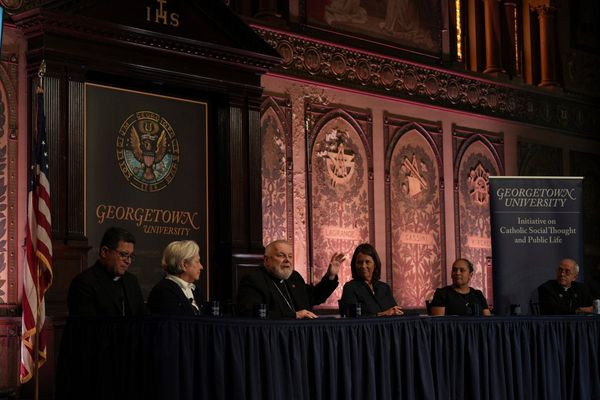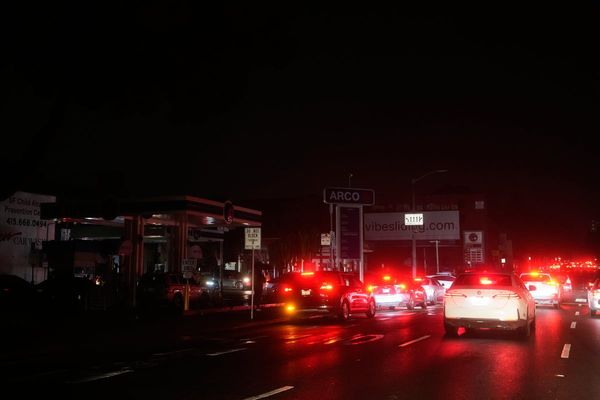
The first voice you hear in Larry Achiampong’s new film, Wayfinder, is that of his eight-year-old daughter, Zael. “The beginning of every story starts at the end of another,” she says, with the endearing hesitancy of a young reader approaching a sentence for the first time. “This story starts at the end of a world we once knew.”
The words are intended by the British-Ghanaian multimedia artist to evoke the language of fairytales and science fiction, but also to capture the dystopian, end-of-days tenor of the past few years. However, delivered by Zael, against a black title screen, they are made strange, removed from the familiar language of the art world and placed within the context of family, childhood and bedtime stories.
“Definitely,” says Achiampong, from his studio on the Essex coast. “Removing my voice or my face is very important to me in my art, but so is working with family and friends. I’m thinking about film-makers like Shane Meadows, where they bring their own language and community of actors to the table. You get that sense of working-class familiarity.”
This simultaneous combination of the strange, the familiar and the working-class experience is a good way to describe Wayfinder and Achiampong’s art in general. Set during a non-specific pandemic, the film follows a character called the Wanderer, a young girl played by Perside Rodrigues who is rambling across England, from Hadrian’s Wall via a Wellingborough housing estate, to a cup of tea at E Pellicci’s cafe in London and a night-time stroll through the Turner wing of the National Gallery before arriving at Margate and the sea.

Made during lockdown, it’s a film influenced by personal ideas of fear and isolation, but also wider notions of class, empire, history and national identity. “The pandemic affected so much,” says Achiampong, 37. “The scenes where the Wanderer wears the weird gas mask? I made those masks for my family in the early days of the pandemic when I wasn’t sure what was going on. I was separated from my kids who I co-parent for a quarter of a year so, yeah, that trauma fed into the film.”
During her journey, the Wanderer encounters people, both real and fictional, who draw out the film’s wider themes of empire, division and belonging, from a bolshie cafe guest voiced by Russell Tovey to the first female Black British Olympian, Anita Neil, and, in one of the film’s most powerful moments, a griot played by artist Mataio Austin Dean, who sings a haunting version of a 17th-century English folk ballad, Lord Thomas and Fair Eleanor, AKA The Brown Girl.
“I met Mataio at the Slade School,” explains Achiampong, referring to the London art college, “and was totally astonished by his approach to English and British folk songs in relation to his own Guyanese-English heritage. He came up with the idea of singing different versions of The Brown Girl. That reinterpretation of UK heritage and history is something I’m quite familiar with, in terms of my Ghanaian heritage.”
I tell Achiampong I’ve watched the film three times and am still discovering new things in it. “It’s really for the audience to make their own connections,” he says. “But Mataio and I spoke about this idea of unrequited love, in terms of living in the UK for someone who is other, or not white; the yearning to be a part of something that is pushing you out. For example, the Wanderer’s meeting with Anita Neil. This person is an icon, the first Black British Olympian. She should be celebrated – and had you heard of her? I didn’t even know about her until I started making the film. I decided to focus on her sense of pride, that sense of belonging pushed up against that other kind of energy, making us feel like we’re not a part of England, let alone the United Kingdom. There’s a love story within that. I guess I wanted to focus on the difficulty of that love story.”
That difficult love story can be seen in the artist’s earliest works, such as 2007’s Lemme Skool U, a series of family portraits in which the face of the young Achiampong has been replaced by a “Cloud Face”, a black circle with exaggerated cartoon-like red lips inspired by the racist “golly” caricature that used to be the mascot on Robertson’s jam.

“When I created the first Cloud Face image,” explains Achiampong, “I thought about the Robertson’s gollies but I wasn’t trying to create that kind of caricature. I wanted there to be an almost otherworldly aesthetic to them where even gender becomes confused. I’m still making Cloud Face pieces. I made a short film in 2013 where I created a Cloud Face helmet and walked through Tate Modern, imagining them as this kind of explorer figure.”
The explorer figure also fed into Achiampong’s ambitious 2016 project, Relic Traveller. Inspired by the fallout from Brexit, Achiampong created a quadrilogy of short, haunting sci-fi films that charted the progress of space-suited “Relic Travellers” across a British landscape ruined by nationalism, collecting evidence of the colonial past. The films were influenced, in part, by the British-Ghanaian film-maker John Akomfrah but also by video games such as The Legend of Zelda.
“That’s where my film language comes from,” says Achiampong. “The Sega MegaDrive, the Super Nintendo, where anything feels possible and you feel like you could jump through portals into a whole different environment. We were a working-class family. I wasn’t afforded the privilege of going to galleries at a young age but I was being shown art in another way.”
Out of this way of thinking and organising ideas grew Achiampong’s guiding conceptual principle, Sanko-time. “It brings together two words,” he explains. “Sankofa” is a Twi word from Ghana, which means to go back and retrieve something that may be in front of you that you never noticed. It’s also me thinking about time travel as a way of revisiting the past in order to prepare for the future.”

One of the most striking examples of Sanko-time is Achiampong’s roundel for Westminster tube station. Installed in 2019, it’s based on his 2017 Pan-African Flag for the Relic Travellers’ Alliance which flew above Somerset House during his 2017 residency; the standard red, white and blue Underground scheme replaced with the Pan-African colours of red, gold and green and 54 stars representing the 54 countries in the African Union. I tell him that visiting the station to see the roundel felt like I was simultaneously stepping off on to a new platform in a computer game while also arriving at an alternate future.
“This is the language I speak with!” says Achiampong, laughing. “I’m a gamer, I love playing within environments. I never felt British flags were speaking to me, about me or for me, so it was beautiful to have this opportunity to create this new design and hear people say they felt recognised as a result of that.”
There is an optimism and irony inherent in Achiampong’s use of the colours and the countries of the African Union, an organisation that aims to achieve greater unity, integration and solidarity across African nations. It’s the polar opposite to the dystopian vision of Britain he depicts in his Relic Traveller and Wayfinder films, a vision rooted in family, childhood, class and the city he grew up in.
“As a kid, I used to do cleaning jobs in the city with my mum very early in the morning or late at night,” says Achiampong. “So when the pandemic happened I was already familiar with the emptiness of the city but also the roles that key workers play, travelling like ghosts through the empty cityscape. I’d help my mum with cleaning jobs in big offices, TV studios, places where people were not great at cleaning their desks, leaving wrappers or whatnot. My mum would say to me, ‘You know, these people – if we weren’t here, give it one day and their world would be flipped upside down.’ That stayed with me.”
• Larry Achiampong’s Wayfinder exhibition is at the Turner Contemporary Gallery, Margate until 19 June before touring to the MK gallery in Milton Keynes and Baltic in Gateshead. The exhibition also includes the largest UK presentation of Achiampong’s Relic Traveller project, plus a curated display of JMW Turner paintings referenced in Wayfinder and a Gaming Room showcasing video games that have influenced Achiampong’s work.







